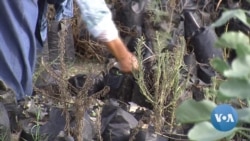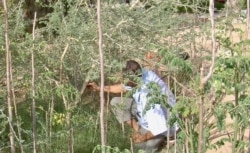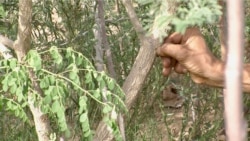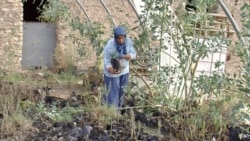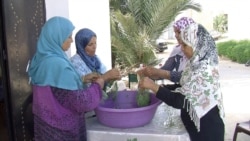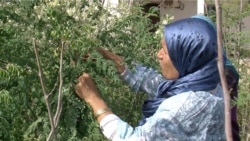Samira Sghaier and a group of friends prune moringa trees under a searing sun, dropping fistfuls of leafy branches into plastic tubs. Prickly acacias edge the plot of land, protecting bone-dry soil from further erosion.
Sghaier’s father once grew olive and fruit trees — varieties that mostly shriveled and died under her watch. “There hasn’t been enough rain in recent years,” says the 52-year-old farmer.
Her tiny farm in eastern Tunisia is a bellwether for the dramatic environmental changes already reshaping North Africa, which threaten to intensify with climate change.
Sandwiched between an encroaching Sahara and a warming Mediterranean Sea, the region has seen a sharp drop in rainfall over the past half century—a trend experts say will likely intensify in the coming decades. Indeed, over the course of this century parts of North Africa as well as the Middle East might become uninhabitable, according to the German research and policy organization, the Max Planck Institute.
“We’re seeing higher temperatures and increasing water stress,” says Essia Guezzi, climate and energy project officer for conservation group WWF North Africa, summing up some of the regional challenges. Meanwhile, rising sea levels threaten the region’s largely coastal populations, she and others note.
These and other issues will come into sharp focus during next month’s climate summit in Spain, a fellow member of the Mediterranean region that is considered a climate hotspot—more vulnerable to the effects of climate change than other parts of the world.
While Morocco has earned praise as a climate-change leader, the North African region overall needs to do much more to counter an otherwise grim future, experts say. Also hampering efforts: some countries are buffeted by conflict and civil unrest, while fossil fuels continue to drive Algerian and Libyan economies.
Trying to turn the tide
In Tunisia, fresh groundwater reserves are shrinking rapidly. Roughly two-thirds of the land is threatened by desertification. The effects of climate change are likely to slow the country’s growth, hitting two major revenue drivers—tourism and agriculture—according to a 2018 report by the Netherlands Foreign Ministry.
While Tunisian authorities have outlined ambitious targets — including cutting emissions 41 percent by 2030 compared to 2010 levels—they have been slow to match words with action, critics say. Nor did the issue figure high on candidates’ priorities in recent legislative and presidential elections.
“It seems like the environment and the impact of climate change is the last concern of many Tunisian politicians,” says Hamadi Gharbi, WWF North Africa Climate and Energy project manager, who says the country also needs more climate financing and expertise.
In the village of Bir Salah, Sghaier is trying, at least locally, to turn the tide. She and other area farmers began planting hardy acacia trees to help reduce erosion, along with moringa, a fast-growing plant prized for its nutritional and medicinal properties.
The idea was to help fight climate change and earn a profit doing so. The reality has not been so easy.
“Everyone likes new products,” Sghaier says, showing a visitor her storeroom packed with moringa oils and powders, along with bags of moringa-based bsissa, a Tunisian breakfast drink, which a group of growers have made and packaged.
“The problem is selling them,” she says. “It’s hard to find a market.”
Regional fight
Across the Sahara, the African Union has spearheaded an ambitious ‘Great Green Wall’ initiative aimed to restore degraded land across a swathe of the Sahel, while also offering income-generating opportunities for communities living there.
“The goal is to replant trees, to return the Sahel to what it was about 60 years ago, when there was a lot more forest cover,” says anthropologist Gilles Boetsch, director of a French scientific team working with Senegalese researchers in the region.
There are plenty of setbacks he says. Many trees die and need to be replaced, while conflict in some Sahel countries makes areas inaccessible.
“It doesn’t work 100 percent, but it works,” Boetsch says, adding a similar regional initiative could also work north of the Sahara. “The first problem is water. The second is getting communities to accept the projects.”
In North Africa, some national projects to fight climate change are making a difference, and Tunisia will reportedly present a regional oases protection project at the Madrid climate conference.
Local farmers in northern Algeria are getting Mexican expertise to plant prickly pear, a cactus that offers a raft of nutritional and money-generating benefits and needs little rainfall. Algeria is also trying to revive a massive ‘Green Dam’ reforestation project that previously had disappointing results.
In Tunisia’s southeastern Gabes region, Dhafer Guezguez worked with the local government in European Union-financed projects that included restoring oases and reintroduce native date palm species. The plants are hardy and nutritious, he says, but not as sweet as popular commercial varieties. Attracting consumers will need serious marketing.
“They need to be showcased as a product that’s rare and good for you,” Guezguez says. “The same kind of effort we saw in Europe and the United States to get people to eat organic products.”
The oases preservation initiatives have helped to boost local economies and restore depleted soil, he says. Women dominate the workforce. The projects have continued even after EU financing ended. Participants are also making tourist handicrafts like palm leaf bags and hats, to earn extra revenue.
“I think this is how, little by little, we can save the oases,” Guezguez says. “When local communities realize it’s in their interest to do so.




